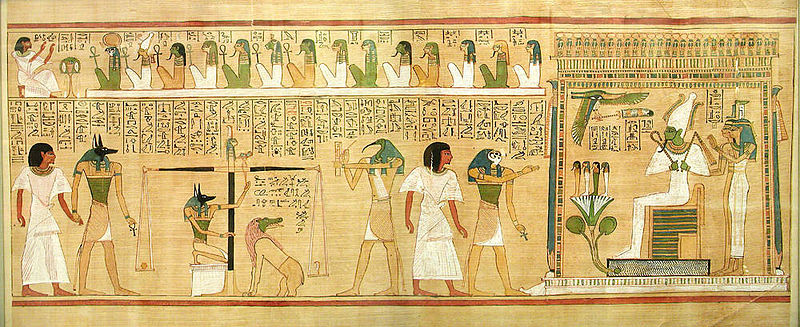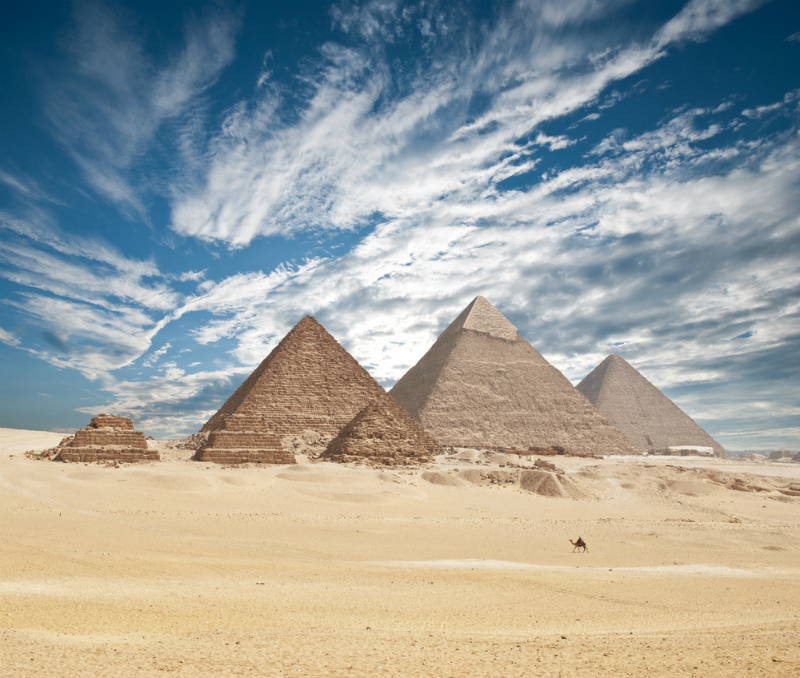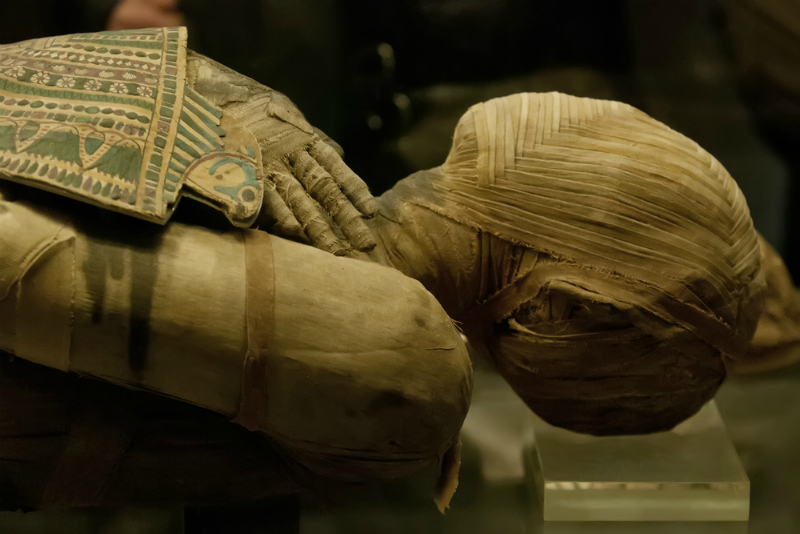Ancient Egyptian culture is fascinating to travelers, and draws millions to the country every year (when the political situation in the country is not too volatile). But much of what we think we know about pyramids, mummies and hieroglyphics is not in fact true. Blame it on outdated research, or films like Indiana Jones and The Mummy. Here are 15 myths about ancient Egypt that we’ve decided to set the record straight on.
A version of this article originally appeared on AFKInsider.com.
1. Ancient Egyptians communicated with extra-terrestrials
Some believe the pyramids were built by alien colonies, or to communicate with them; others see evidence of aliens in ancient Egyptian artwork. TV Programs like the History Channel’s “Ancient Aliens” (in the U.S.A.) promote such ideas with the flimsiest of evidence. In fact, the Egyptians were skilled engineers and determined of their own accord — without the help of non-human life forms — that the multi-dimensional triangular shape of a pyramid was the most structurally sound way to build a massive tomb structure. And instances of alien-like figures in artwork and murals have perfectly mundane explanations, according to Egyptologists.
2. Slaves were forced to build the pyramids
While we’re on the topic of pyramids, lets put to rest another misconception. The pyramids were such an enormous undertaking that many believe no one would willingly build them. This has lead to the widespread belief that pharaohs enslaved hundreds of people and forced them to build. Recently discovered graves show that builders were buried with honor near pharaohs — which actual slaves wouldn’t be entitled to. The pyramids were most likely built by villages of workers who lived near the construction site, a project that united neighboring communities and most likely inspired pride in the people.
3. Egyptians invented hieroglyphics
Hieroglyphs are a topic of perennial popularity, and most people believe the Egyptians invented them — but scholars now believe that West Asian invaders most likely introduced this unique form of art-writing to Egypt. Also contrary to popular belief, the hieroglyphs were not used to cast curses or do magic spells — they were mainly used to depict historical events or write inscriptions on tombs.
4. Mummies still have their hearts
The famous Greek historian Herodotus speculated a lot about the mummification process, and one of the most popular speculations was that mummies still have their hearts intact. For the most part, only royalty or the very wealthy got to keep their hearts after death.
5. If a Pharaoh died, so did his servants
Two eccentric Pharaohs from the First Dynasty of Egypt are known to have had their servants buried with them, which resulted in many Egyptologists speculating that all 300-plus Pharaohs did the same. But archaeology has not shown this to be true. In fact, many later pharaohs were buried with shabtis, small figurines that were intended to be “helpers” for the king in the afterlife.
6. It’s bad luck to open a tomb
The movie “The Mummy” reinforced this myth, which originated with explorer Howard Carter’s initial discovery and opening of Tutankhamun’s tomb. Of Carter’s team of 58 people, eight died within a dozen years of opening the tomb, prompting many to speculate that the tomb was cursed. Though there is some truth to the theory that fungus on the walls of the tomb may have caused a couple of the deaths, most of the deaths are purely coincidental and they would have occurred even had they not entered the tomb.
7. Cleopatra was beautiful
Stories of Cleopatra’s power over men has led many to deduce that she was physically stunning, but carvings and artwork made of her during her lifetime have shown her to have masculine features that are not considered beautiful by current Western standards. In fact her large nose, protruding chin, and thin lips mean she most likely did NOT look like Elizabeth Taylor, who played her in the movie “Cleopatra.” Cleopatra was, however, very charming and intelligent, which could be part of the reason that she won so many men’s hearts and minds.
8. Cleopatra was Egyptian
Despite her name being synonymous with ancient Egypt, Cleopatra was actually Greek. She was part of the Greek Ptolemaic dynasty, which ruled Egypt during the Hellenistic era. (Her family was the descendants of Ptolemy, one of Alexander the Great’s generals.) Cleopatra was the last ruler in the Ptolemaic line; after a military defeat by the Romans and her death by suicide, Egypt became a Roman province.

An except from the Egyptian Book of the Dead, a collection of spells designed to guide the deceased in the afterlife (John Bodsworth, Wikimedia Commons)
9. Ancient Egyptians were fascinated with death
Considering the giant pyramids were built as resting places for the dead, ornate gifts placed inside of tombs, complex funeral rites and a two-month-long embalming process for mummies, it’s easy to believe the Egyptians were obsessed with death. But relics of death just happen to be the artifacts that have survived though the millenia most successfully. The truth is that the ancients were much more likely to have been consumed with LIFE. For example, if you look at the objects that were placed inside the deceased’s tombs, they all pertain to promoting a comfortable afterlife. And even the carvings on the walls of tombs depict scenes of farming, hunting and fishing.
10. Arabs burned the library of Alexandria
Legend has it that when Arabs conquered Egypt in 640 AD, Caliph Omar ordered the books in the great library of Alexandria to be burned. (Supposedly the books provided enough fuel to heat the city’s saunas for 6 months.) However, historians doubt the veracity of this tall tale because written accounts of it do not appear until the late 12th century. If the library was sacked and burned in the 7th century, why was it not written about until more than 500 years after the fact?
11. Everything about Ancient Egypt has been fully discovered
Many believe that we have discovered everything we can about Ancient Egypt, and that Egyptology as such can go no further forwards. But in fact, fascinating discoveries are still being made about Egypt’s grand past. From the actual process used to make mummies, to important insights about their health and life using modern technology to further investigate Ancient Egyptian remains. And even today new discoveries are still being made. A ‘solar boat’ has been found and extracted from the Great Pyramid of Giza. It is thought that this solar boat would allow the dead Pharaohs to assist the sun-god Ra in his eternal battle with Apep, demon of darkness. According to legend, every night, Ra sails his solar boat into combat with Apep and at dawn he emerges triumphant and cruises across the sky.
12. Pyramids were not decorated
Everyone is familiar with the colourful hieroglyphs that cover the interior of many Ancient Egyptian tombs. But for a long time, it was thought that the pyramids were undecorated inside. Until, that is, a secret door was found in the Great Pyramid, behind which were found hieroglyphs. And while we may think of the pyramids as plain and relatively austere, there is evidence that some sections, such as interior pillars, were actually painted red or white — nor were the pyramids simply huge stone edifices, as they appear today. Because these were the tombs of the pharaohs, they were designed to be the most impressive structures in Ancient Egypt. The outside was originally covered with a smooth, white limestone, polished until it was dazzlingly bright in the sun. (You can still see some of the remnants of this limestone outer shell on the Great Pyramid. The rest was all removed centuries ago.) It was said that the pyramids reflected the light from the moon or the sun, and could be seen from miles around, even at nighttime. If that wasn’t enough, the capstone on the very top of the pyramid was plated in either gold or electrum.
13. Ancient Egyptians are the same as the modern Egyptians
There is a belief that today’s populace of Egypt are the same as those from antiquity. However, the modern population reflects the influx of many peoples via migration, occupation and conquest, including the Assyrians, Persians, Greeks, Romans, Arabs and Turks. There are of course descendants of the original Egyptians from antiquity, but it would be foolish to make wild surmises (such as “there were no Nubians in ancient Egypt”) based solely on the current population.
14. Walk like an Egyptian
It is a common misconception that all Ancient Egyptian art employs stylised figures who are viewed side on. But in fact, there are numerous examples of naturalised and beautiful depictions of animals and people, which bears witness to the quality of the artists’ observations. Egyptian art was in fact highly developed and reached incredible artistic heights, which we are still striving to understand. Witness the artistry across the various medium: gold, obsidian, glass, tomb paintings, sculpture and papyri. Most fun perhaps are the examples where the artist really let their hair down and turned the world upside down, showing cats herding geese.
15. Napoleon is responsible for the loss of the Sphinx’s nose
A popular legend lays the blame for the loss of the nose on Napoleon and his troops during the French Campaign in Egypt (1798-1801). It is commonly claimed that the soldiers used the Sphinx for target practice, and shot off its nose. However, it is clear from the records that the nose of the Sphinx had already disappeared much earlier. European visitors often made drawings during their tours, and sketches of the Sphinx by Frederic Louis Norden, made in 1738, clearly show the Sphinx was already noseless. This lets Napoleon off the hook as he was only born in 1769.
Related content on AFKTravel:
10 Most Fascinating Pyramids of Egypt
QUIZ: How Much Do You Know About These Ancient Egyptian Monuments?
15 Must-See Ruins To Visit In Egypt
Want to discover the finer side of Africa? Sign up for our weekly newsletter.










